Spanning the River Thames, a stone’s throw from the Tower of London, and attracting some 40,000 visitors a year, Tower Bridge is not just a marvel of Victorian engineering, it’s been an iconic symbol of London ever since it opened 130 years ago – on 30th June 1894.
Why was it built?
In the late 19th century, London was growing rapidly, and the East End of London was experiencing a surge in population and commercial activity. The only bridge across the Thames at that time was London Bridge, which was unable to cope with the increased levels of traffic. The only answer therefore was to build a new bridge downstream of London Bridge and thus ease congestion.
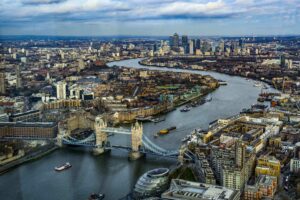
The Design and Construction
The design for the new bridge was selected through a public competition held in 1876. Over 50 designs were submitted. The winner was Sir Horace Jones, the City Architect, whose design was approved in 1884. Jones collaborated with John Wolfe Barry, a civil engineer, who proposed the idea of a bascule bridge to allow ships to pass through (‘bascule’ comes from the French for ‘seesaw’).
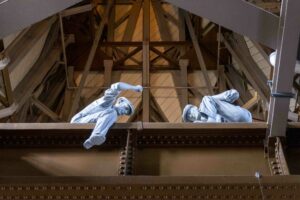
Construction began in 1886 and took eight years to complete, with the relentless labour of 432 construction workers. Over 70,000 tons of concrete were sunk into the riverbed to support the two massive piers, and the bridge’s framework was made using over 11,000 tons of steel. This was then clad in Cornish granite and Portland stone in Scottish Baronial/Neo Gothic style, thus creating a romantic silhouette to complement the Tower of London next door.
How Tower Bridge works
When it was built, Tower Bridge was the largest and most sophisticated bascule bridge ever completed. The bascules were operated by hydraulics, using steam to power the enormous pumping engines.
The energy created was stored in six massive accumulators, meaning that as soon as power was required to lift the Bridge, it was always readily available. The accumulators fed the driving engines, which drove the bascules up and down. Despite the complexity of the system, the bascules only took 60 seconds to raise to their maximum angle of 86 degrees.
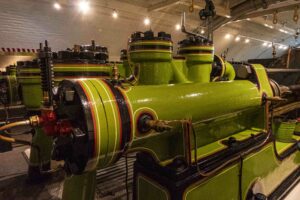
Today, the bascules are still operated by hydraulic power, but since 1976 they have been driven by oil and electricity rather than steam. The original pumping engines, accumulators and boilers are now on display in the Bridge’s Engine Rooms.
Opening and early years
Tower Bridge was officially opened on June 30, 1894, by the Prince of Wales (the future King Edward VII) and his wife, the Princess of Wales (later Queen Alexandra). The event was marked with great pomp and ceremony, with the bridge instantly becoming a celebrated landmark of London.
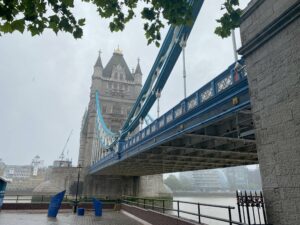
In its early years, the bridge was a vital artery for both pedestrians and vehicles. The bascules were raised approximately 20-30 times a day, allowing ships to pass through. Today the bascules are raised approximately 800 times a year, and the Tower Bridge website publishes bridge lift times. Look out for regular users Will and Gladys (sailing barges), and the Paddle Steamer Dixie Belle.
The Upper Walkways
Connecting the two towers (and providing extra stability to the structure) are two walkways. These were initially open to the public and provided spectacular views of the city. However, they were closed in 1910 as they were rarely used. Unsurprisingly, pedestrians preferred to stand and watch the bridge go up and down. The walkways had also become notorious as a haunt for pickpockets and prostitutes. They were reopened in 1982 as part of the Tower Bridge Exhibition.
Glass floors were installed in 2014 – strong enough to support two black taxi cabs – and they give a great view of the road and river beneath.
Tower Bridge Miscellany
- By law a bundle of hay must be suspended from Tower Bridge when work is underway. This alerts ships that there is less room to pass under its bascules.
- Tower Bridge was originally painted a bright chocolate brown – a colour favoured by Queen Victoria. It was repainted Battleship Grey prior to World War 2 as camouflage, and repainted red, white and blue in 1977 to mark the Queen’s Silver Jubilee – the same colours we see today.
- A rigorous test of the bascules’ strength was carried out a few days before the official opening. A colossal weight of steam rollers, traction engines and trolleys were placed at the farthest extremity of the south bascule. A deflection of just one and a half inches was recorded – much to the engineers’ delight.
- On 9th August 1912, just nine years after the Wright Brothers’ initial flight, aviator Frank McClean flew his Short hydroplane between the road and upper walkways of Tower Bridge, and continued upstream dipping under every bridge as far as Westminster. However, on the return journey, as he attempted to fly under Tower Bridge, a sidewind hooked him into the water. Fortunately, he was unhurt and his beloved seaplane was towed away for repair.
- Frank Miller, a chemist from Essex was fined for flying an aircraft through Tower Bridge on 25th November 1951. His excuse? His son had dared him to do it for 35 shillings. Unfortunately for Frank, it didn’t cover the £100 fine.
- During World War 1 an anti-aircraft gun was attached to top of the upper walkway. Known as ‘Barking Charlie’ it’s effectiveness may have been debatable but its importance as a symbol of resistance was undeniable.
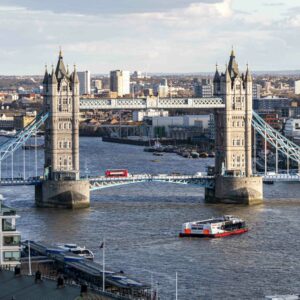
Find out more about the history of Tower Bridge and plan a visit, visit the website at:
https://www.towerbridge.org.uk/
There’s also a free display celebrating 130 years of Tower Bridge at the Guildhall Art Gallery until 19th September:
https://www.cityoflondon.gov.uk/events/tower-bridge-at-the-heritage-gallery
